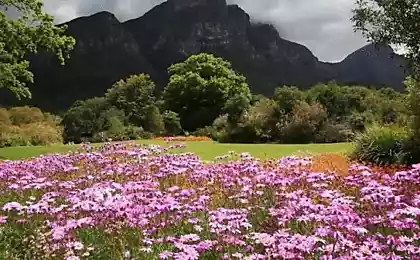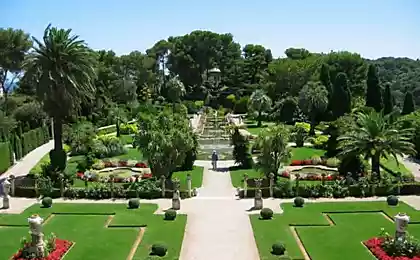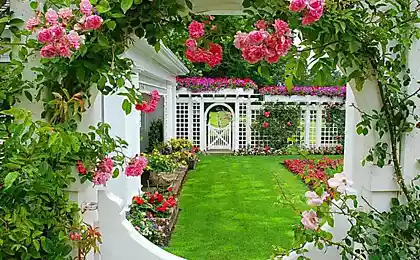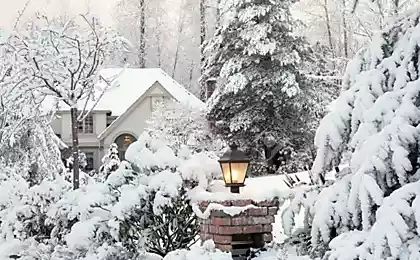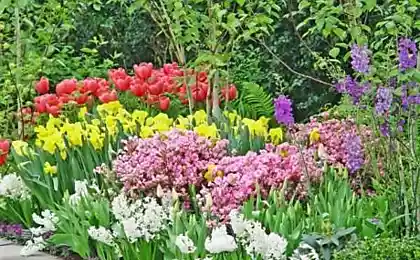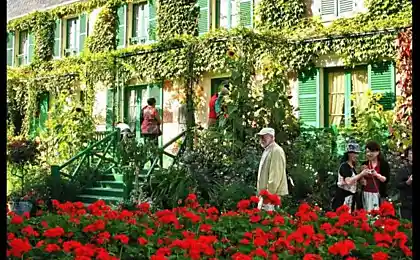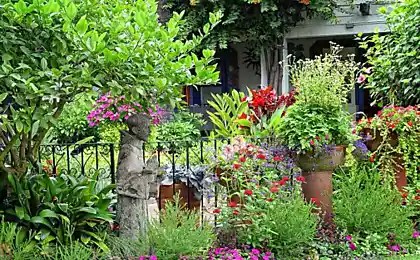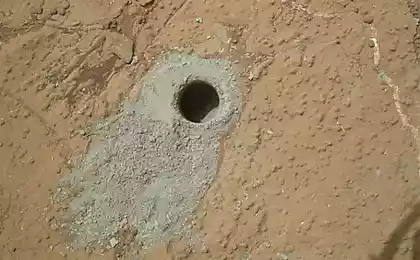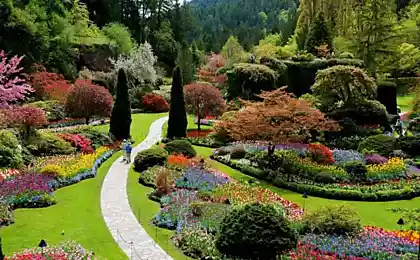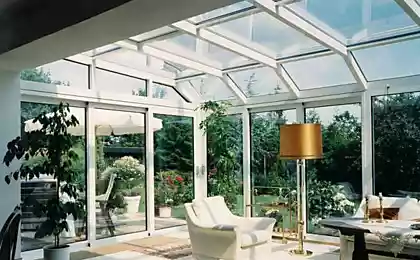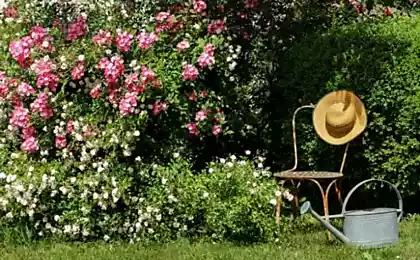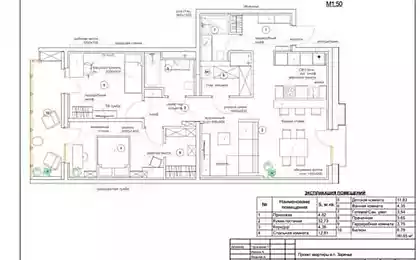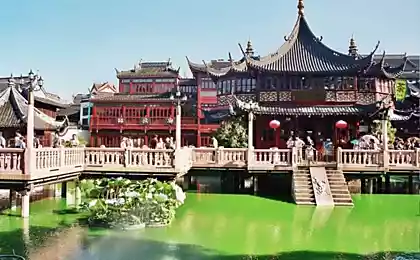565
Five rules for garden without pests and diseases
If the plant a suitable place, conditions of environment and soil, it will root and will delight you with its appearance. The right conditions is the right immunity. And for good immunity necessary prevention of diseases!
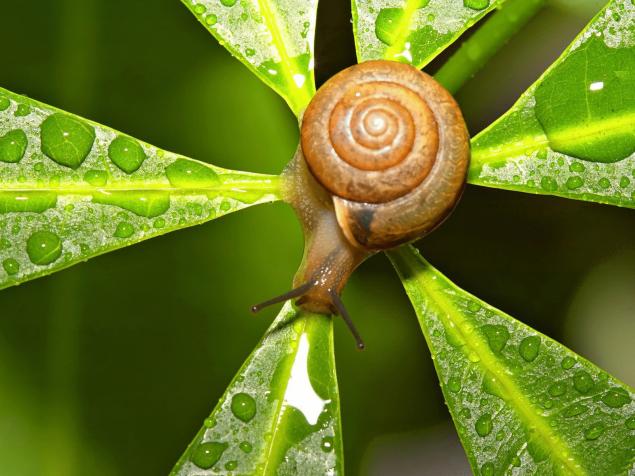
If the plant a suitable place, conditions of environment and soil, it will root and will delight you with its appearance. The right conditions is the right immunity. And for good immunity necessary prevention of diseases!
If the plants in the garden if they get sick or affected by pests, of which the decoration can be discussed! We also have extra material costs for treatment plants and to purchase new instead of the victims, or spend time growing new plants from scratch.
Disease is the infection of plants by viruses or bacteria and also condition, caused by a lack of any nutrients.
Pests – it is an external aggression on the part of different living creatures. Varieties of pests is very much greater than the causes of diseases. In different situations, pests can become different beings. It can be insects. It may be small animals, rodents or birds. It can be plants, in other words, weeds. Why, despite the struggle, they appear? This happens when there are a number of conditions.
Which is conducive to pests and diseases:
1. Shaded, low-lying area with high humidity.
2. The plot is adjacent to a field, meadow or forest.
3. The neighbors did not take any measures against pests, in or near abandoned land.
4. Your site is located on former farmland.
5. A poorly ventilated area.
6. The year is conducive to diseases or pests.
There are also "fruitful" years to certain pests, for example, there are years when too many aphids everywhere, and in the woods and in the field, not only on the site. It is difficult to fight in General, it is necessary only "in particular".
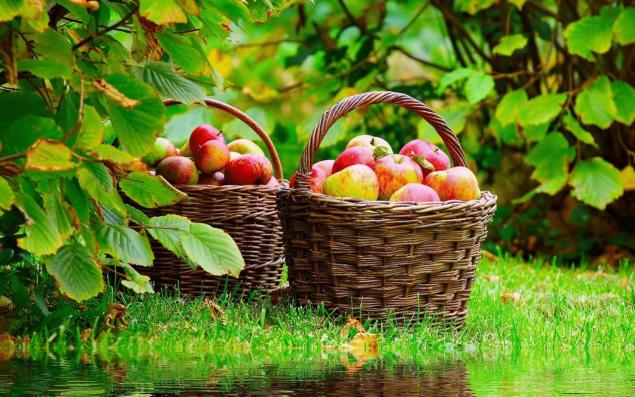
That means we need to redouble efforts to protect their plants. In order to save your garden from pests and diseases, sufficient to comply with five basic principles:
Rule 1. Proper soil preparation and planting Soil at the landing site, you need to double dig, to saturate it with oxygen, you need to choose all roots of perennial weeds. Then you need to fix in the soil a certain amount of mineral fertilizers (depending on the consumption norms prescribed on their packaging). Choose a fertilizer depending on the characteristics of your soil, but versatile recipe – add a little fertilizer for lawns, compost and humus.
The best time for planting most saplings – early spring: April and may, but not later than may 15. Autumn can be planted, but it is worse. The soil for planting should be prepared in advance and tailored to the needs of specific plants. Trees, shrubs, conifers and flowers of the requirements are different. Before planting trees or shrubs need to prepare in advance a garter stakes, and conifers are strictly oriented to the cardinal – they need to be put in the same position as they were in the nursery (the side of ephedra, which was located to the North in the nursery, similarly, must be oriented toward the North when landing). Any plant is best planted with "carnevino".
Rule 2. The biological relationship of the Use of these relationships is the use of the forces of nature. For example, the same pest is part of the natural community of equal beings, not designed to harm us personally, but to maintain the biological balance and also there are limiting factors. That's when the balance for some reason is violated, the number of so-called "pests" increases, and they become a problem for the garden. So the struggle is to use the "deterrent" mechanisms of nature. You can use the following steps:
1. Keep planting after the "right" predecessors, in other words, the "rotation". Ornamental garden, of course, no garden, but the principles are the same. A rotation exists for ornamental plants. Basic rule: never plant a plant on the place, which before it, grew the plant of the same species. In an extreme case, it should take 4-5 years. For perennial flowers 3-4 years for annuals only two years. If this is not possible, be sure to completely change the soil in the landing site.
2. Raise the plants, deterring pests. Of course, not all, but many. There are a number of plants that "don't like" the majority of pests. It's herbs, onions, garlic, wild garlic, marigolds, nasturtium, celandine, yarrow, nightshade, chamomile, ferns. Bitter taste, and is not important. Hell, for example, is affected by aphids. Apparently, it plays the role of secreted substances.
3. Don't plant plants that attract a record number of pests. There are a number of such plants. For example, from hawthorn in the garden is better to abstain.
4. Destroy the "reservation" pests of which you are aware. For example, always clean up fallen leaves. In late autumn cut off the ends of young shoots of viburnum – and you will completely destroy masonry aphids.
5. Increase the number of natural enemies of garden pests. Attract garden birds, use less aggressive chemistry, because then you die and useful garden insects, including those where the pests – natural prey. Let your garden will be places, which could shelter amphibians and hedgehogs. Cats in the garden – the salvation of mice and moles.
6. However, in winter do not hang bird feeders for decorative trees or shrubs, look for alternative locations. The fact that fallen seeds attract to the garden mice. Or fertilize Tits fat. 7. Fight pests not only in the garden, but also outside it.
8. Take a large part of the plot and beautiful parts, lawn, flower beds and mosinee, do not leave the "wild" areas – and the weeds you will have simply nowhere to settle.
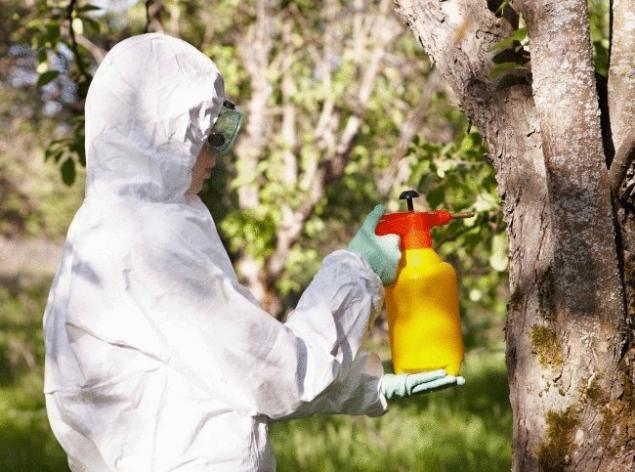
Rule 3. Not "run" the garden means small problems decide to cut, as "proceeds". Cut the dried and diseased branches, defects, bark and hollows to clean healthy wood, treat with iron supplementation, paint over oil paint. Hollows and depressions fill with foam. Fight the visible weeds, proplyvaya, if necessary, the lawn. With the appearance of local places of pests treat these lesions natural remedies: tobacco dust, tincture of garlic, tomato leaves, yarrow, chamomile, wormwood, sometimes with a solution of soap (only economic, not toilet). Against ants use ground cinnamon.
Rule 4. Keep the garden clean Periodically remove the debris, dry leaves, rotten fruits and berries, cut branches, in this kind of stuff often overwinter pests, the breeding of bacteria and fungi, moreover, it attracts rodents. Remove various inorganic waste, do not scatter according to the phase cut parts of plants, keep the lawn cut the grass, do not allow thickening of the garden, keep the garden well ventilated and receive ample sunlight. As a result, you severely reduce populations of pests and diseases, especially fungal infections.
5. Use of plant protection products there Are various situations, for example, the vagaries of the climate: anomalous frosts in winter, freeze in summer, the lack of sun, drought, crop damage, and similar problems – resulting in reduced plant immunity. Then increase the immunity artificially: treat ornamental plants immunomodulators "Appin" and "Zircon". If, however, the plants have obtained a specific problem, try to determine whether you are dealing with a disease or pest? There is a certain natural state of plants that appearance of concern, but to struggle with them is not necessary. Maybe the plant lacks water or has a place of excess waterlogging. Maybe it's a natural cycle in the life of the plant. For example, the emergence of a large number of yellow needles on a pine tree means nothing. Just conifers are also gradually changing their needles, and you saw this moment. To fight must begin not with the most drastic means. Often help means "people". Try natural remedies: tobacco dust, a tincture of garlic, tomato leaves, pepper, yarrow, chamomile, sage, cheese whey. Processing is performed in two ways: if the plant is large, for example, is a tree or a tall shrub, use a sprayer, but if it is a small shrubs, perennials and flowers, using hand spray.

Sometimes, if the little pests, you can try to flush them with a garden hose, and then to the processing plant. If "folk" remedies don't help, only then it is necessary to use chemical means of protection of plants. It is very important strictly observe the instructions specified on the package. For any such processing, it is necessary to choose the right time: the processing is better done in the evening, from 18 to 21 hours, the wind on this day to be weak, there should not be rain and the temperature should be above 8 degrees Celsius. In extreme cases, if after 6-8 hours it rains, it's not scary. Important the first 6-8 hours. In General, and generally, when working with any chemicals, except immunomodulators, it is always safer to wear a raincoat and rubber boots, and use a mask.
Source: domashniy.ru/

If the plant a suitable place, conditions of environment and soil, it will root and will delight you with its appearance. The right conditions is the right immunity. And for good immunity necessary prevention of diseases!
If the plants in the garden if they get sick or affected by pests, of which the decoration can be discussed! We also have extra material costs for treatment plants and to purchase new instead of the victims, or spend time growing new plants from scratch.
Disease is the infection of plants by viruses or bacteria and also condition, caused by a lack of any nutrients.
Pests – it is an external aggression on the part of different living creatures. Varieties of pests is very much greater than the causes of diseases. In different situations, pests can become different beings. It can be insects. It may be small animals, rodents or birds. It can be plants, in other words, weeds. Why, despite the struggle, they appear? This happens when there are a number of conditions.
Which is conducive to pests and diseases:
1. Shaded, low-lying area with high humidity.
2. The plot is adjacent to a field, meadow or forest.
3. The neighbors did not take any measures against pests, in or near abandoned land.
4. Your site is located on former farmland.
5. A poorly ventilated area.
6. The year is conducive to diseases or pests.
There are also "fruitful" years to certain pests, for example, there are years when too many aphids everywhere, and in the woods and in the field, not only on the site. It is difficult to fight in General, it is necessary only "in particular".

That means we need to redouble efforts to protect their plants. In order to save your garden from pests and diseases, sufficient to comply with five basic principles:
Rule 1. Proper soil preparation and planting Soil at the landing site, you need to double dig, to saturate it with oxygen, you need to choose all roots of perennial weeds. Then you need to fix in the soil a certain amount of mineral fertilizers (depending on the consumption norms prescribed on their packaging). Choose a fertilizer depending on the characteristics of your soil, but versatile recipe – add a little fertilizer for lawns, compost and humus.
The best time for planting most saplings – early spring: April and may, but not later than may 15. Autumn can be planted, but it is worse. The soil for planting should be prepared in advance and tailored to the needs of specific plants. Trees, shrubs, conifers and flowers of the requirements are different. Before planting trees or shrubs need to prepare in advance a garter stakes, and conifers are strictly oriented to the cardinal – they need to be put in the same position as they were in the nursery (the side of ephedra, which was located to the North in the nursery, similarly, must be oriented toward the North when landing). Any plant is best planted with "carnevino".
Rule 2. The biological relationship of the Use of these relationships is the use of the forces of nature. For example, the same pest is part of the natural community of equal beings, not designed to harm us personally, but to maintain the biological balance and also there are limiting factors. That's when the balance for some reason is violated, the number of so-called "pests" increases, and they become a problem for the garden. So the struggle is to use the "deterrent" mechanisms of nature. You can use the following steps:
1. Keep planting after the "right" predecessors, in other words, the "rotation". Ornamental garden, of course, no garden, but the principles are the same. A rotation exists for ornamental plants. Basic rule: never plant a plant on the place, which before it, grew the plant of the same species. In an extreme case, it should take 4-5 years. For perennial flowers 3-4 years for annuals only two years. If this is not possible, be sure to completely change the soil in the landing site.
2. Raise the plants, deterring pests. Of course, not all, but many. There are a number of plants that "don't like" the majority of pests. It's herbs, onions, garlic, wild garlic, marigolds, nasturtium, celandine, yarrow, nightshade, chamomile, ferns. Bitter taste, and is not important. Hell, for example, is affected by aphids. Apparently, it plays the role of secreted substances.
3. Don't plant plants that attract a record number of pests. There are a number of such plants. For example, from hawthorn in the garden is better to abstain.
4. Destroy the "reservation" pests of which you are aware. For example, always clean up fallen leaves. In late autumn cut off the ends of young shoots of viburnum – and you will completely destroy masonry aphids.
5. Increase the number of natural enemies of garden pests. Attract garden birds, use less aggressive chemistry, because then you die and useful garden insects, including those where the pests – natural prey. Let your garden will be places, which could shelter amphibians and hedgehogs. Cats in the garden – the salvation of mice and moles.
6. However, in winter do not hang bird feeders for decorative trees or shrubs, look for alternative locations. The fact that fallen seeds attract to the garden mice. Or fertilize Tits fat. 7. Fight pests not only in the garden, but also outside it.
8. Take a large part of the plot and beautiful parts, lawn, flower beds and mosinee, do not leave the "wild" areas – and the weeds you will have simply nowhere to settle.

Rule 3. Not "run" the garden means small problems decide to cut, as "proceeds". Cut the dried and diseased branches, defects, bark and hollows to clean healthy wood, treat with iron supplementation, paint over oil paint. Hollows and depressions fill with foam. Fight the visible weeds, proplyvaya, if necessary, the lawn. With the appearance of local places of pests treat these lesions natural remedies: tobacco dust, tincture of garlic, tomato leaves, yarrow, chamomile, wormwood, sometimes with a solution of soap (only economic, not toilet). Against ants use ground cinnamon.
Rule 4. Keep the garden clean Periodically remove the debris, dry leaves, rotten fruits and berries, cut branches, in this kind of stuff often overwinter pests, the breeding of bacteria and fungi, moreover, it attracts rodents. Remove various inorganic waste, do not scatter according to the phase cut parts of plants, keep the lawn cut the grass, do not allow thickening of the garden, keep the garden well ventilated and receive ample sunlight. As a result, you severely reduce populations of pests and diseases, especially fungal infections.
5. Use of plant protection products there Are various situations, for example, the vagaries of the climate: anomalous frosts in winter, freeze in summer, the lack of sun, drought, crop damage, and similar problems – resulting in reduced plant immunity. Then increase the immunity artificially: treat ornamental plants immunomodulators "Appin" and "Zircon". If, however, the plants have obtained a specific problem, try to determine whether you are dealing with a disease or pest? There is a certain natural state of plants that appearance of concern, but to struggle with them is not necessary. Maybe the plant lacks water or has a place of excess waterlogging. Maybe it's a natural cycle in the life of the plant. For example, the emergence of a large number of yellow needles on a pine tree means nothing. Just conifers are also gradually changing their needles, and you saw this moment. To fight must begin not with the most drastic means. Often help means "people". Try natural remedies: tobacco dust, a tincture of garlic, tomato leaves, pepper, yarrow, chamomile, sage, cheese whey. Processing is performed in two ways: if the plant is large, for example, is a tree or a tall shrub, use a sprayer, but if it is a small shrubs, perennials and flowers, using hand spray.

Sometimes, if the little pests, you can try to flush them with a garden hose, and then to the processing plant. If "folk" remedies don't help, only then it is necessary to use chemical means of protection of plants. It is very important strictly observe the instructions specified on the package. For any such processing, it is necessary to choose the right time: the processing is better done in the evening, from 18 to 21 hours, the wind on this day to be weak, there should not be rain and the temperature should be above 8 degrees Celsius. In extreme cases, if after 6-8 hours it rains, it's not scary. Important the first 6-8 hours. In General, and generally, when working with any chemicals, except immunomodulators, it is always safer to wear a raincoat and rubber boots, and use a mask.
Source: domashniy.ru/


